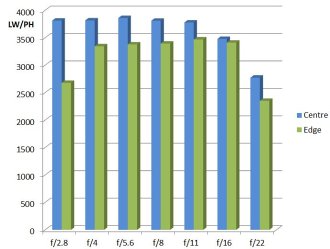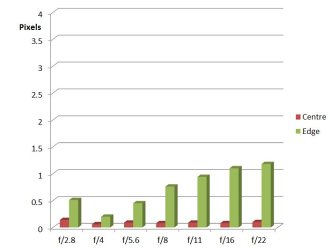Sony FE 90mm f/2.8 Macro G OSS Review
Sony FE 90mm f/2.8 Macro G OSS Performance
Sharpness is very impressive. Centrally, results are excellent from f/2.8 to f/16, remaining very good even at f/22 as diffraction starts to take the edge off things. Edge sharpness starts off at a very good level at f/2.8 and is excellent from f/4 to f/16. At f/22 diffraction reduces edge sharpness but results remain good.
How to read our charts
The blue column represents readings from the centre of the picture frame at the various apertures and the green is from the edges.The scale on the left side is an indication of actual image resolution as LW/PH and is described in detail above. The taller the column, the better the lens performance.
For this review, the lens was tested on a Sony Alpha A7R II using Imatest.
CA (Chromatic Aberration) in almost zero centrally and generally kept under one pixel at the edges. This is not particularly obtrusive, but in any event can be handled in software. Flare is also totally absent and even against the light images have good contrast and sharpness.
How to read our charts
Chromatic aberration is the lens' inability to focus on the sensor or film all colours of visible light at the same point. Severe chromatic aberration gives a noticeable fringing or a halo effect around sharp edges within the picture. It can be cured in software.Apochromatic lenses have special lens elements (aspheric, extra-low dispersion etc) to minimize the problem, hence they usually cost more.
For this review, the lens was tested on a Sony Alpha A7R II using Imatest.
Distortion is respectably low at -0.599% barrel, a figure that is unlikely to be a problem in general photography. This too can be handled in software if required.
The bokeh of this 90mm is very smooth indeed. Out of focus backgrounds look good, with none of the “busy” appearance that some deliver. This is well maintained as we stop down, no doubt helped considerably by the virtually circular aperture.
This is all a very high and even standard of performance and the lens lives up to its heritage and delivers the quality expected.
Of course all this would be to no avail if the results were marred by camera shake. With a lens as crisp as this there is actually a higher expectation in that the difference between utterly crisp, sharp and not sharp can be more obvious. My results indicate that images are utterly crisp hand held down to 1/100 second and sharp down to 1/15 second. They are borderline at 1/8 second and hopelessly unsharp at ¼ second. This is around a three stop improvement compared to images shot with OSS switched off, a significant difference. Others may do better or worse, depending upon how steady they are when hand holding. However well it works for any individual, it is clear that OSS is an extremely valuable asset.
Value For Money
The Sony FE 90mm f/2.8 Macro G OSS is priced at £899. To see how this compares with other full frame AF macro lenses we need to look at the main DSLR ranges. The comparable marque lenses might be the Canon EF 100mm f/2.8L Macro IS USM (£659), the Nikon 105mm f/2.8 G AF-S VR IF ED Micro (£659) and the SMC Pentax-D FA 100mm f/2.8 Macro WR (£449).
In Sony FE fit there are also two Samyang manual focus macro lenses. The 100mm f/2.8 ED UMC Macro is priced at £319 and the 100mm T3.1 ED UMC Macro Video lens at £349.
This all makes the Sony a bit on the expensive side, however it is a very, very good lens which may well rather redress the balance.
For more options have a look at the Top 10 Best Macro Lenses.
Add your message
Please login here or if you've not registered, you can register here. Registering is safe, quick and free.
photodo Stats
428 MTF tests
74 in-depth photodo reviews
100+ users join each day
Help the lens community by reviewing or rating a lens today via our lens search
Latest Lens Reviews
- Chinon 28mm f/2.8 Vintage Lens Review
- Canon EF 70-200mm f/4L IS II USM Lens Review
- Samyang AF 85mm f/1.4 EF Review
- Sigma 70mm f/2.8 DG Macro Art Review
- Samyang AF 24mm f/2.8 FE Review
- Meike 50mm f/1.7 Review
- Tamron 70-210mm f/4 Di VC USD Review
- Lensbaby Burnside 35mm f/2.8 Review
- Asahi Super Takumar 50mm f/1.4 Review
- Asahi Super-Multi-Coated Takumar 135mm f/3.5 Review


